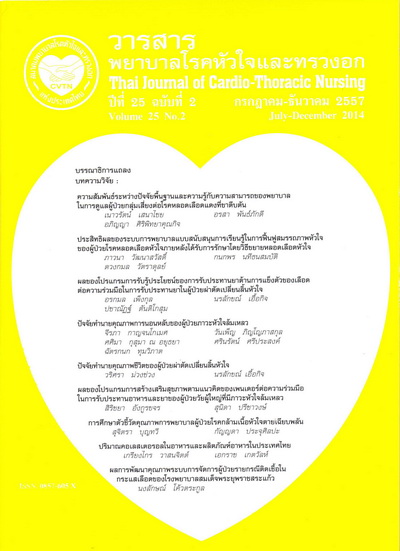ความสัมพันธ์ระหว่างปัจจัยพื้นฐานและความรู้กับความสามารถของพยาบาล ในการดูแลผู้ป่วยกลุ่มเสี่ยงต่อโรคหลอดเลือดแดง ที่ขาตีบตัน
คำสำคัญ:
โรคหลอดเลือดแดงที่ขาตีบตัน, ความรู้ของพยาบาล, ความสามารถของพยาบาล, ผู้ป่วยกลุ่มเสี่ยง ต่อโรค PAD, Peripheral arterial disease, Nurses’ knowledge of PAD, Nurses’ competency, Patients at risk of PADบทคัดย่อ
ผู้ที่เป็นโรคหลอดเลือดแดงที่ขาตีบตัน (Peripheral Arterial Disease : PAD) มีโอกาสเกิดความพิการเนื่องจากถูกตัดขา ดังนั้นความสามารถของพยาบาลในการประเมินและค้นพบโรค PAD โดยเร็วและให้การดูแลผู้ป่วยกลุ่มเสี่ยงต่อโรค PAD จึงมีความสำคัญ การวิจัยครั้งนี้มีวัตถุประสงค์เพื่อศึกษาปัจจัยที่สัมพันธ์กับความสามารถของพยาบาลในการดูแลผู้ป่วยกลุ่มเสี่ยงต่อโรค PAD ได้แก่อายุ ระยะเวลาในการปฏิบัติงาน ประสบการณ์การดูแลผู้ป่วย PAD การฝึกอบรมเพิ่มเติม แผนกที่ปฏิบัติงาน และความรู้เกี่ยวกับโรค PAD โดยใช้ทฤษฎีความพร่องในการดูแลตนเองของโอเร็ม กลุ่มตัวอย่างเป็นพยาบาลวิชาชีพปฏิบัติงานในแผนกอายุรกรรมและแผนกศัลยกรรม โรงพยาบาลสกลนคร จำนวน 122 คน เก็บรวบรวมข้อมูลโดยใช้แบบสอบถามข้อมูลส่วนบุคคล แบบสอบถามความรู้เรื่องโรค PAD และแบบสอบถามความสามารถในการดูแลผู้ป่วยกลุ่มเสี่ยงต่อโรค PAD วิเคราะห์ข้อมูลโดยใช้สถิติบรรยาย สัมประสิทธิ์สหสัมพันธ์สเปียร์แมน และไคสแควร์
ผลการศึกษาพบว่า กลุ่มตัวอย่างส่วนใหญ่มีความสามารถในการดูแลผู้ป่วยกลุ่มเสี่ยงต่อโรค PAD โดยรวมและรายด้านอยู่ในระดับปานกลาง 3 ด้านคือ การคัดกรอง การให้ความรู้ และการให้คำแนะนำในการปฏิบัติตน ส่วนความรู้เกี่ยวกับโรค PAD ส่วนมากมีความรู้โดยรวมและรายด้านอยู่ในระดับน้อยใน 4 ด้านคือ อาการ และอาการแสดง ความรุนแรงของโรค การตรวจวินิจฉัยโรค และการรักษาโรค ความรู้เกี่ยวกับโรค PAD (rs = .40, p < .01) และแผนกที่ปฏิบัติงาน (χ2 = 8.49, p < .01) มีความสัมพันธ์กับความสามารถของพยาบาลในการดูแลผู้ป่วยกลุ่มเสี่ยงต่อโรค PAD อย่างมีนัยสำคัญทางสถิติ
ผลการศึกษาครั้งนี้เสนอแนะให้มีการส่งเสริมให้พยาบาลมีความรู้เกี่ยวกับโรค PAD และพัฒนาทักษะ ในการให้ความรู้ การดูแล และการป้องกันผู้ป่วยที่มีความเสี่ยงต่อโรค PAD
Relationship among Nurses’ Basic Conditioning Factors,Knowledge, and Competency for Providing Care of Patients at Risk of Peripheral Arterial Disease
Patients with peripheral arterial disease (PAD) are at risk of amputation and disability. The ability of nurses to early detect and provide care for patients at risk of PAD to prevent limb loss and death is important. This descriptive study aimed to examine nurses’ competency in providing care for patients at risk of PAD and included factors such as age, duration of work, experience of providing care to patients with PAD, additional training, departments of work, and nurses’ knowledge of PAD that are related to nurses’ competency. The samples were 122 registered nurses working in medical and surgical departments, in Sakonnakhon hospital. Data were collected by using three questionnaires: demographic data, knowledge of PAD, and competency in providing care for patients at risk of PAD. Descriptive statistics, Spearman rank-order correlation coefficient and Chi-square were employed to analyze the data.
Results of the study revealed that the samples had a moderate level of overall and each dimensions of competency in providing care for patients at risk of PAD in screening, providing knowledge, and offering self-care advice. They had a low level of overall and each dimensions of knowledge about PAD in signs and symptoms, severity, diagnosis, and treatment of PAD. Knowledge of PAD (rs = .40, p < .01) and departments of work (χ2 = 8.49, p < .01) were significantly associated with the nurses’ competency in providing care for patients at risk of PAD.
This finding suggested that nurses should enhance their knowledge and skill of PAD and should trained in the dissemination of knowledge, providing care and prevention for patients at risk of PAD.
ดาวน์โหลด
รูปแบบการอ้างอิง
ฉบับ
ประเภทบทความ
สัญญาอนุญาต
บทความนี้ยังไม่เคยตีพิมพ์หรืออยู่ในระหว่างส่งไปตีพิมพ์ในวารสารอื่น ๆ มาก่อน และกองบรรณาธิการขอสงวนสิทธิ์ในการตรวจทาน และแก้ไขต้นฉบับตามเกณฑ์ของวารสาร ในกรณีที่เรื่องของท่านได้ได้รับการตีพิมพ์ในวารสารฉบับนี้ถือว่าเป็น ลิขสิทธิ์ของวารสารพยาบาลโรคหัวใจและทรวงอก






